|
Filmmakers have a long history of putting themselves in their movies, from the drawn-from-life texturing of characters and locations to specific recreation of episodes from their lives. Sometimes these elements are easy to spot (when Bill Douglas makes a film titled My Childhood and locates it in the district in which he was born and raised, it's a safe bet that this is not a work of creative fiction), while others may be detectable as recurring themes and motifs or the sort of character detail that only stems from experience. Altogether more interesting is when the autobiographical element is not initially evident and its later discovery prompts a very different reading the film in question.
Such was certainly the case with David Cronenberg's 1979 The Brood. On my first viewing I took it for the masterly and inventive horror tale we all assumed it was and nothing more. Only later did I discover that the film grew from directly from the director's experience of a painful divorce and child custody battle. If you watch the film with this in mind and it really does change how you respond to the story and specific scenes. It's still a terrific horror film, but now it is also a troubling tale of the pain of marital breakdown and its destructive effect on children who get caught in the crossfire. But there was even more going on he that I initially realised. Only later did I discover some crucial specifics of this traumatic divorce, that Cronenberg abducted his own child after his wife fled with her and joined a religious cult. Knowing this makes the film even more disturbing, exposing as it does the level of anger and bitterness that the then young filmmaker must have felt towards his partner. If you're looking for confirmation, check out the quote at the top our my review of the 2003 region 1 DVD from MGM here, where you'll also find my review of the film itself.
Watching The Brood again after a gap of several years, I do feel I was perhaps that I was a little too dismissive of Art Hindle's contribution in that earlier review. Although overshadowed by the powerhouse work of Oliver Reed and (especially) Samantha Eggar, he delivers a solid and commendably restrained performance as concerned husband and father Frank and Cronenberg's stand-in. But I also failed to mention how good the then eight-year-old Cindy Hinds is as young Candice. Rarely, if ever, have I seen a child actor who so conveys such a vivid sense of suppressed trauma through her facial expression and body language alone – her vacant stare and sometimes painful sadness repeatedly seem to hover on the brink of collapse into uncontrollable despair. In this viewing especially, the final act sight of her hunched up in a corner, eyes covered, knees drawn and shaking with fear, brought a sizeable and unexpected lump to my throat.
In other respects, though, I stand by the earlier review, and the key focus here is how the film shapes up on what I'm fairly sure is its first ever Blu-ray incarnation.
I have to admit that my expectations for the picture quality on this Blu-ray release were hampered by the usual preconceptions when approaching a low-budget 80s horror film. These are films we may caught once in the cinema a long time ago but remember more clearly for the grubby VHS versions that later followed, and while the transfer on the 2003 MGM region 1 DVD was pretty good for its day, the film has never exactly sparkled on any previous home video incarnation.
Approach this new transfer with that in mind and you're in for a big and very pleasant surprise, as depending on where you hop to when you first play the disc (I tend to go to chapter stops when first checking out the disc of a film I already know well), the transfer here knocks the spots off of MGM's DVD. The spotless image is far sharper and more detailed than I would ever have anticipated and although generally brighter than the DVD, at its best the contrast is absolutely spot on. This more pleasing balance of contrast and brightness reveals a range of previously invisible shadow detail and gives the image a vibrancy I would never before have associated with the film. While generally pitched at about the right level, very occasionally this does feel pushed a little too far, notably the exterior wide shot when Frank first drives up to confront Raglan about Candice's bruises, where the brightening of the image more clearly reveals it for what it is, a daylight shot in which night has been simulated by darkening the sky with a graduated filter.
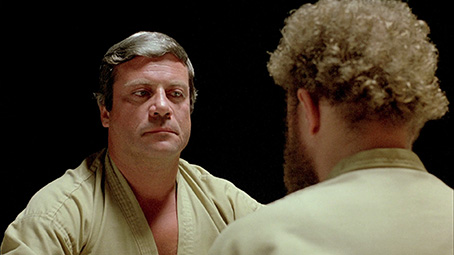
The first shot of the film as it appears on Second Sight's region B Blu-ray (above) and MGM's 2003 region 1 DVD (below)
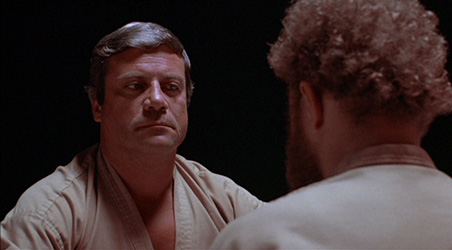
In common with a number of recent HD transfers of films from 70s and 80s, the colour has also been digitally retimed, bringing a green/brown tint to many scenes that at it's strongest all but eliminates other colours. This is particularly evident in the opening psychoplasmics demonstration, where the slightly more naturalistic hues of the MGM DVD have been tweaked to such a degree that the scene almost now looks almost like it was shot in artificial light on daylight balanced film. Elsewhere, though, colours have been vividly reproduced, evident in the yellow of the door and the poster at the police station, the bright primes and pastels of cold weather coats, the stained glass window in the Carveth's bathroom, and, of course, the red of the blood. Grain is visible but does not feel digitally enhanced; the few close-ups of Eggar in the climactic confrontation where it appears more prominent and the sharpness drops a little look to be the result of frame enlargement at the editing stage.
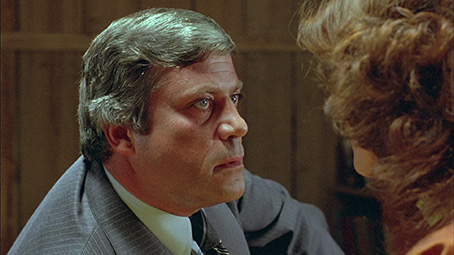
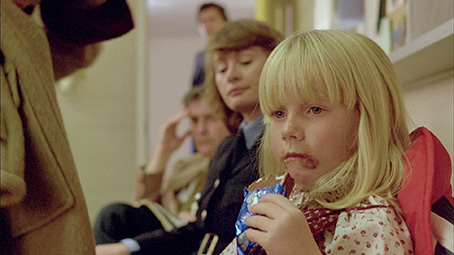
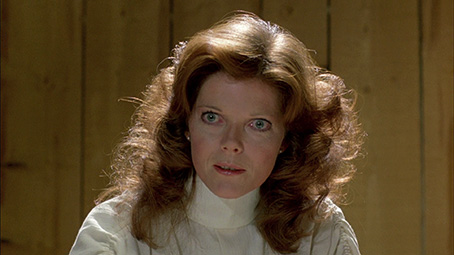
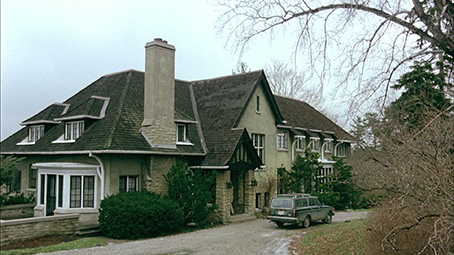
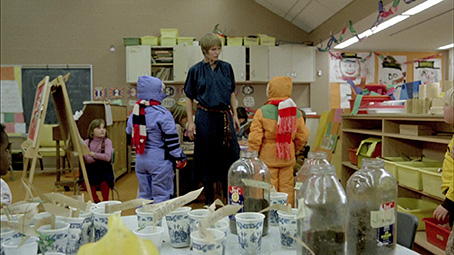
The Linear PCM 48 mono 2.0 soundtrack has the expected minor range restriction and treble bias in the dialogue, but is otherwise clear and free of damage and background hiss. The deeper strings of Howard Shore's moody and dramatic score are particularly well handled.
English subtitles for the hearing impaired have also been included.
If the picture upgrade were not enough, Second Sight have also delivered a solid collection of worthwhile extra features, all similar in style and quality to those you'll find on their recent Blu-ray of Cronenberg's follow-up film, Scanners.
Producing The Brood (11:00)
Executive producer Pierre David, who worked with Cronenberg on three films – The Brood, Scanners and Videodrome – is interviewed in the same spot and session in which his chat on Second Sight's Scanners Blu-ray was recorded – he even mentions Scanners at one point and adds "I'll get to that later," and this is clearly the first half of that interview. David is every bit as interesting and animated as he was on the previous disc, and here discusses the funding of the arts in Canada, how he first became involved in the film, its moderate success and later cult following, and his fond memories of making films with Cronenberg, whom he still regards as one of the most talented filmmakers he has worked with. Inevitably, perhaps, he also talks about Oliver Reed and particularly Reed's drinking (this is obliquely referenced in the Scanners interview when he refers to Patrick McGoohan as "another Brit actor who drank like crazy") and he remains bemused at how Reed could get drunk every night and show no after effects on set the next morning. A story about Reed's arrest for making good on a bet that he'd walk naked through the town is rather amusing.
The Look of Rage (13:33)
In the second companion piece to the Scanners extras, cinematographer Mark Irwin reveals how he came to first work with Cronenberg on the 1979 Fast Company (there's some interesting stuff here) and talks about the film's autumnal colour palette, his first real immersion in the Cronenberg mindset, and working with Samantha Eggar and Oliver Reed. Reed's drinking comes up, providing a different story to the one told by Pierre David, but Irwin still looks back on working with the actor as something of a career highpoint. It's also he that confirms some of the details of the conflict between Cronenberg and his ex-wife that inspired the film.
Meet the Carveths (19:48)
Chris Alexander, editor-in-chief of Fangoria magazine, talks to actors Art Hindle and Cindy Hinds, who played husband Frank and daughter Candice. Both recall how they landed their respective roles and some specific memories of working on the film, and Hindle claims it was one of the toughest movies he has ever done, while the then young Hinds was taken good care of and had a great deal of fun. Both recall Oliver Reed's wild living and the aforementioned arrest for his nude walk bet, and Hinds remembers that having completed the film she was unable to see it, being legally too young.
Character for Cronenberg (10:24)
An unexpected treat for hardcore Cronenberg fans is this brief but welcome interview with actor Robert A. Silverman, who has played a variety of wonderfully quirky supporting roles in a total of five Cronenberg films. He provides a fairly detailed timeline of his early life and work, including his slow recovery from a serious car accident and his admiration for Cronenberg's art house debut double of Stereo and Crimes of the Future. He and the director have remained good friends and he delights in having been in more Cronenberg films than any other actor.
David Cronenberg – The Early Years (13:16)
Well this was unexpected, given the absence of similar on the Scanners Blu-ray, an interview with David Cronenberg himself about his early career. Engaging as ever, he reveals how he got into film making in the first place and talks about his relationship with film company Cinépix, how he learned on the job, how one particularly bad review scared off the investors at Telefilm and seriously delayed the production of Rabid, the importance of horror films, and more. What's missing is any discussion about The Brood itself, a film Cronenberg has also declined so far to provide a commentary track for on any disc release. Could the near impossibility of dancing round the inspiration for the film and a number of key scenes – memories he may be reluctant to revisit – be responsible for this?
A smart and consistently involving body-horror film with a seriously tense climax, The Brood is, for my money, still one of Cronenberg's best and most important films. Colour issues aside, the transfer is as good as the film has looked on home video by a considerable margin and is bolstered further by a series of splendid interviews. Second Sight is starting to carve themselves a serious rep for their quality Blu-ray releases of cult favourites from the 70s and 80s, and this is no exception. More please!
|